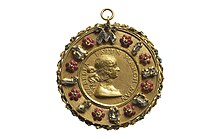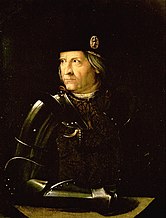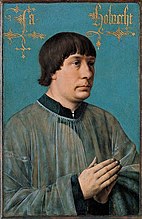Music year 1505
◄ | 1501 | 1502 | 1503 | 1504 | Music year 1505 | 1506 | 1507 | 1508 | 1509 | ► | ►►
Overview of the music years
Further events
| Music year 1505 | |
|---|---|
|
Ercole I. d'Este
On June 15th, Ercole I. d'Este, one of the most important art patrons of the Renaissance, dies in Ferrara. |
Jacob Obrecht
Less than a month after his employer, the Franco-Flemish composer Jacob Obrecht died of the plague in Ferrara. |
Events
- Alexander Agricola , who accompanied his employer Archduke Philip the Fair of Castile from November 4, 1501 to November 8, 1503 on his journey to Spain , France , Austria and Germany , has returned to Mechelen . He is still a member of the Archduke's Grande Chapelle .
- Marco Dall'Aquila , who around the autumn of 1504 asked in letters to the leadership and the council of the city-state of Venice ( Serenissimi Principi and Sapientissimi Consiglio ) for a ten-year privilege to publish his not yet in print lute pieces himself, which he “with the greatest effort and not only medium-sized costs ”, received this privilege on March 11, 1505. But he does not seem to have made use of it. He probably consideration made to the music publisher Ottaviano Petrucci (1466-1539), who as early as May 1498 in the Republic of Venice for 20 years the exclusive privilege for printing and distribution of Mensuralmus i k and lute and organ tablature had received.
- Antoine Brumel , who has been courted by the d'Este family in Ferrara since around the end of 1504 to work as Kapellmeister in their famous and high-ranking court orchestra, was appointed to this position on December 13, 1505. He will take up the post of Kapellmeister in the spring of 1506.
- Marco Cara has been a lute virtuoso in the service of the Gonzaga family in Mantua since 1495 and until 1525 , who promoted artists of all kinds in his day.
- Josquin Desprez has been provost at his former place of work in Condé-sur-l'Escaut since last year . He is referred to as monsieur le prevost messire Josse des pres . The position is attractive for the former music director not only for its local property ownership, but even more because of the good staffing the church and the quality of the local music exercise, second only to the cathedral in Cambrai and Saint-Vincent in Soignies exceeded becomes. The provost here (according to a list from 1523) holds secular power in the parish and is the superior of the dean , the treasurer, 25 canons, 18 chaplains, 16 vicars and six choirboys, plus some priests without benefices; A choir of vicars and choirboys usually takes part in the lavishly designed church services, so that up to 22 music-trained voices are available and up to six-part works can be performed.
- Antonius Divitis , who has been choirmaster and master of the choirboys at St. Rumbold's Church in Mechelen since last year , is moving to the court orchestra of the Duchy of Burgundy . This institution at the court of Philip the Beautiful is one of the most respected musical institutions of the time. From October 1505, Divitis is a colleague of Pierre de la Rue , Alexander Agricola and Marbrianus de Orto .
-
Duke Ercole I. d'Este , one of the most important art patrons of the Renaissance, dies on June 15th in Ferrara. In the history of music, Ercole is one of the most important Italian nobles who brought the talented Franco-Flemish musicians from Northern Europe to Italy. The most famous composers in Europe either worked for him, received commissions from him or dedicated music to him, including Alexander Agricola , Jacob Obrecht , Heinrich Isaac , Adrian Willaert and Josquin Desprez .
 The only secured portrait of Isabella d'Este , the daughter of Ercole I. d'Este: Portrait medal by Gian Cristoforo Romano 1495 (here as a splendid version from 1505)
The only secured portrait of Isabella d'Este , the daughter of Ercole I. d'Este: Portrait medal by Gian Cristoforo Romano 1495 (here as a splendid version from 1505) - Jehan Fresneau is Procurator of the Chapter of St. Martin at Chartres . This is evident from the last document in which he is mentioned ( February 10, 1505).
- Adam von Fulda , who had been a lecturer there since the University of Wittenberg was founded, dies of the plague .
- In 1505 a Johannes Hennel from Dreßden enrolled at the University of Leipzig to study. Since the name Galliculus is the Latinized form of Hennel or Hähnel, this student is very likely identical with the composer Johannes Galliculus .
- Johannes Ghiselin leaves the court of the d'Este family after the outbreak of the plague in Ferrara .
- Nicolas Gombert is possibly already a pupil of Josquin Desprez († 1521), who has been provost since 1504 in Condé-sur-l'Escaut, about 40 km away .
- Heinrich Isaac lived again mainly in Florence from 1502 to 1506 .
- Clément Janequin is a clergyman in Bordeaux in the service of the humanist Lancelot du Fau.
- Jean Molinet has been a historiographer (chronicler) and court poet at the ducal court of Philip the Fair (reign 1482–1506) in Burgundy since 1482 . Here he is friends with musicians and composers such as Johannes Ockeghem , Loyset Compère , Verjus and Antoine Busnoys .
- Pierre Moulu worked as a chaplain at the Saint-Etienne cathedral in this city from 1505 to 1513 .
- Jacob Obrecht , who has been the director of the court orchestra in Ferrara since September 1504 , becomes unemployed after the death of his patron Ercole I. d'Este. The successor of Ercole I. d'Este, his son Alfonso I. d'Este (reign 1505–1534), reduced the size of the court chapel and dismissed Obrecht. The composer is still trying to get a job in Mantua at the court of Isabella d'Este and Margrave Francesco II Gonzaga , but has no success. Shortly afterwards he returned to Ferrara and worked here as a priest, perhaps in the German or Dutch community. At the end of June or in July 1505 Obrecht died of the plague in Ferrara.
- Marbriano de Orto reached the peak of his artistic career in 1505. In that year, the Venetian music publisher Ottaviano dei Petrucci brought out a collection of masses just by him, a so-called individual print, titled “Misse de Orto”, which is considered a special honor can be. In addition, de Orto will be admitted to the court chapel of Duke Philip the Fair of Castile on May 24th . Here de Orto is a colleague of other composers at the court, such as Pierre de la Rue , Alexander Agricola , Nicolas Champion and Antonius Divitis . De Orto is soon appointed premier chapelain by the Duke , which is also associated with significantly higher remuneration. Perhaps because of this high office, de Orto seems to have practically stopped his composing activity in the following period.
- Leonhard Paminger is already at the age of 10 years in Vienna , where he - a job on the - after a burdensome school choir of St. Stephen can get. There he is highly valued for his deep bass and his skills on the harp , lute and flute .
- Francisco de Peñalosa is a member of the Spanish Royal Chapel. The award of a canonical title by the Spanish king in 1505 attests to the first high point of the esteem Peñalosa held by the royal family.
- Johannes Prioris , who may have been a member of the French court orchestra since the end of the 1480s, is verifiably Kapellmeister ( maître de chapelle ) of the court orchestra from 1503 to 1512 .
- Pierre de la Rue , who accompanied his employer Archduke Philip the Fair of Castile from November 4, 1501 to November 8, 1503 on his journey to Spain, France, Austria and Germany, has returned to Mechelen . He is still a member of the Archduke's Grande Chapelle .
- Konrad Rupff , who has been a member of the Electoral Saxon court orchestra founded in the late 1480s since 1491 , took over his office in 1505 after Adam von Fuldas ' death . In 1505 he was ordained a priest and received a parish loan from St. Margarethe in Kahla .
Instrumental music
- Francisco de la Torre - Alta : Sheet music and audio files in the International Music Score Library Project
Vocal music
Spiritually
- Alexander Agricola - Pater meus agricola est : Sheet music and audio files in the International Music Score Library Project
- Antoine Brumel - Motet Nativitas unde gaudia / Nativitas tua, Dei genitrix : Sheet music and audio files in the International Music Score Library Project
-
Josquin Desprez
- Motet Miserere mei Deus (Psalm 50/51) for five voices (1504/1505), 2nd part: Audi, auditui meo, 3rd part: Domine, labia mea
- Motet Virgo salutiferi (1504/1505), Cantus firmus : Ave Maria, 2nd part: Tu potis es primae, 3rd part: Nunc, caeli regina
- Motet Pater noster, qui es in caelis for six parts (Condé, 1505–1521), 2nd part: Ave Maria
- Missa Hercules Dux Ferrariae : Sheet music and audio files in the International Music Score Library Project
- Missa L'ami Baudichon : Sheet music and audio files in the International Music Score Library Project
- Missa Malheur me bat : Sheet music and audio files in the International Music Score Library Project
- Missa Una musque de Buscaya : Sheet music and audio files in the International Music Score Library Project
- Missarum, Liber 2 : Sheet music and audio files in the International Music Score Library Project
- Erasmus Lapicida - Virgo prudentissima to four votes
- Jacob Obrecht - Missa Hercules dux Ferrariae (lost, mentioned by Heinrich Glarean in the Dodekachordon , Ferrara 1488 or 1504/05?)
-
Marbriano de Orto - 5 Missae : sheet music and audio files in the International Music Score Library Project
- Missa Dominicalis
- Missa Jay pris amours cum duobus patrem
- Missa Lomme poor
- Missa La bella se sied
- Missa Petita camuseta
- Ottaviano Petrucci (Ed.) - Fragmenta missarum : Sheet music and audio files in the International Music Score Library Project
-
Gaspar van Weerbeke
- Credo to four votes
- Credo cardinale to four votes
- Ave mater omnium to four voices
- Ave stella matutina to four voices
- O beate Sebastiane to four votes
- Salve sancta parens to four votes
Worldly
- Pietro Aron - Frottola Io non posso più durare for four voices (in: Frottole libro quinto , Venice)
- Marchetto Cara - Frottola S'io sedo all'ombra : Sheet music and audio files in the International Music Score Library Project
- Josquin Desprez - El grillo : Sheet music and audio files in the International Music Score Library Project
-
Ottaviano Petrucci (Ed.)
- Frottole, Libro 4 : Sheet music and audio files in the International Music Score Library Project
- Frottole, Libro 5 : Sheet music and audio files in the International Music Score Library Project
- Frottole, Libro 6 : Sheet music and audio files in the International Music Score Library Project
- Unknown composer
- Afraid, Alas, and Why so Suddenly? : Sheet music and audio files in the International Music Score Library Project
- Pan de miglio, caldo, caldo : Sheet music and audio files in the International Music Score Library Project
- So el encina : sheet music and audio files in the International Music Score Library Project
Publications
- Marbriano de Orto - Misse Misse de Orto (printed in Venice by Ottaviano dei Petrucci )
Born
Born around 1505
- Andrea Amati , Italian violin maker († 1577 )
- Antoine Barbé , Franco-Flemish composer, conductor and cleric († 1564 )
- Jacquet de Berchem , Franco-Flemish composer and conductor († around 1565 )
- Thomas Crécquillon , Franco-Flemish composer, singer, conductor and cleric († 1557 )
- Guillaume Franc , French composer and collaborator on the Geneva Psalter († 1570 )
- Jean De Latre , Franco-Flemish composer, singer and conductor († 1569 )
- Mattheus Le Maistre , Franco-Flemish composer and conductor († 1577 )
- Luis de Narváez , Spanish composer and vihuela player († after 1549)
- Thomas Tallis , English composer († 1585 )
- Christopher Tye , English organist and composer († around 1572 )
Died
Date of death secured
- June 15 : Ercole I. d'Este , Duke of Ferrara, Modena and Reggio (* 1431 )
- July: Jacob Obrecht , Flemish composer, singer and clerics (* 1457 / 1458 )
Exact date of death unknown
- Adam von Fulda , German composer and music theorist (* around 1445 )
Died after 1505
- Jehan Fresneau , Franco-Flemish composer, singer and cleric (* before 1450 )

